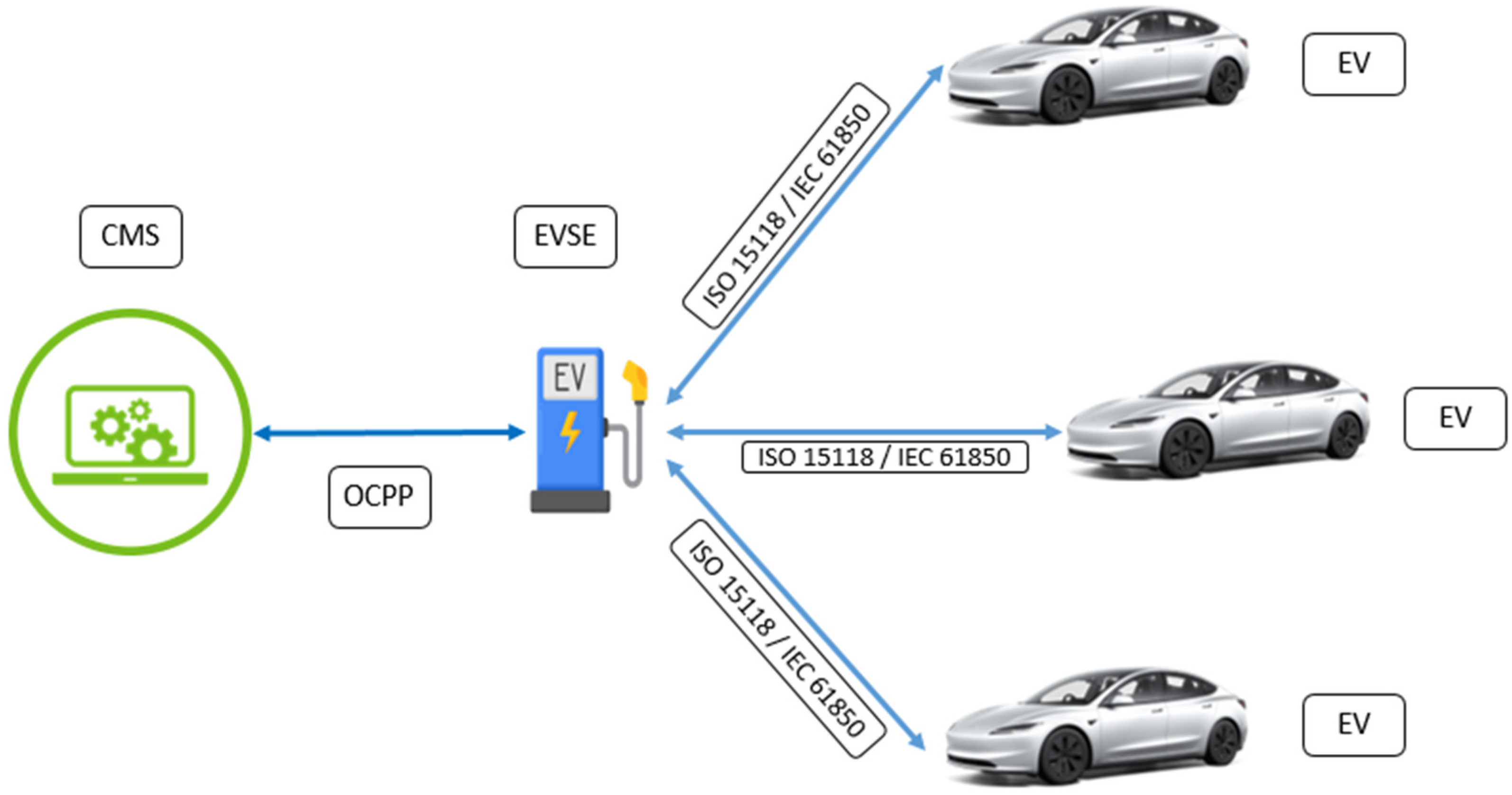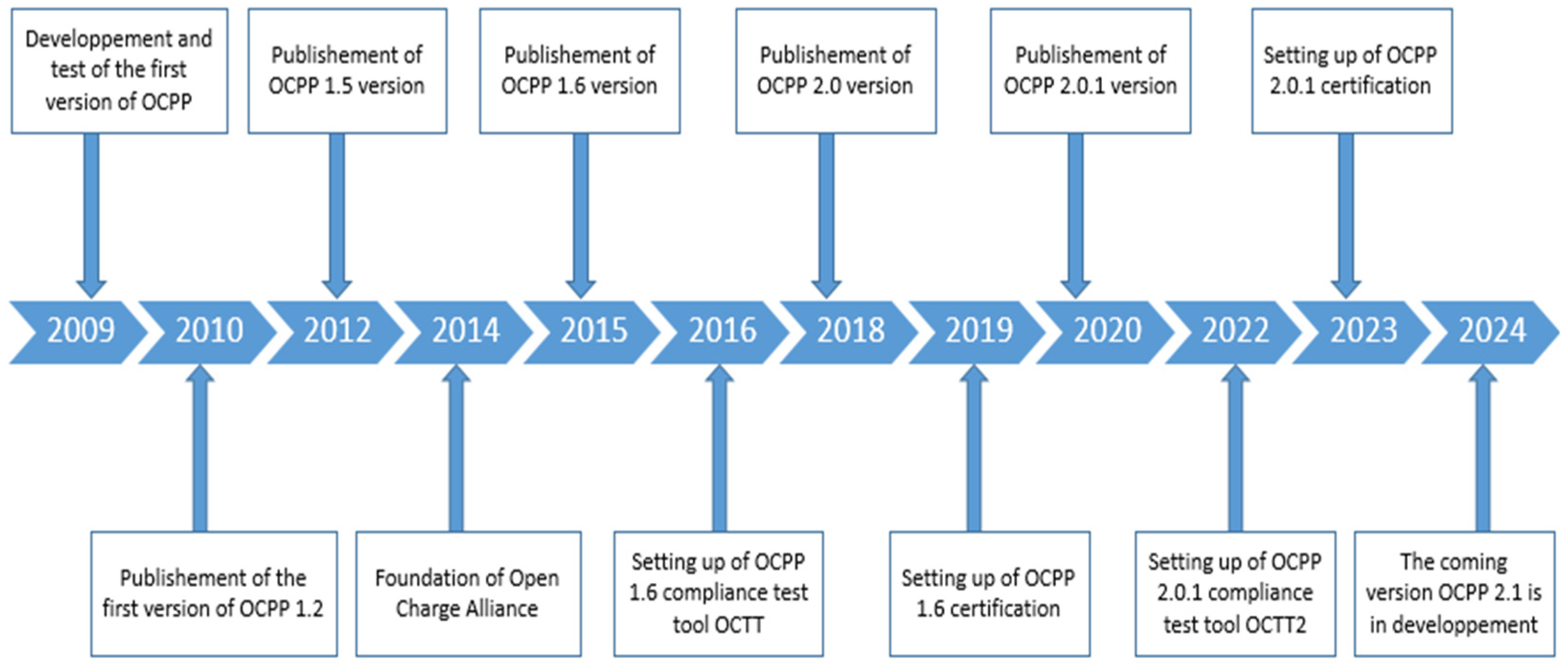Dynamic Pricing for Load Balancing in Electric Vehicle Charging Stations: An Integration with Open Charge Point Protocol †
Abstract
1. Introduction
2. Advantages of Vehicle-to-Grid Protocols
- Smart Charging: This concept is about the intelligent management of electric vehicle charging operations. It is about dynamically regulating between the charging speed, charging duration, and power flow based on multiple factors. For instance, during peak electricity demand periods, the charging speed could be decreased to avoid overloading the electricity distribution grid. In contrast, during periods of low power demand or high renewable energy generation, charging could be accelerated so as to maximize profit from renewable energy generation, which is generally not storable. Smart charging can also involve price-responsive charging, where the charging speed is adjusted based on real-time electricity prices.
- Transaction Optimization: This involves the efficient management of charging transactions to maximize the use of charging infrastructure and minimize costs. For example, the system could prioritize charging for vehicles that are near to having 100% in SOC (state of charge) or for those that have a nearer departure time and so will leave soon. It could also involve load balancing between all of the charging stations which belong to the same central management system to avoid overloading a charging station. Meanwhile, any errors or issues that occur during a transaction can be handled gracefully, with clear information provided to the user. With OCPP, operators can collect and store data on charging station usage patterns, such as the time of day and the duration of charging sessions. This data can be used to optimize pricing strategies and tailor pricing plans for specific user groups. Additionally, OCPP supports dynamic pricing, enabling operators to adjust real-time pricing based on factors such as demand, energy costs, and supply constraints [10].
- Device Management: This concerns the remote monitoring, configuration, and control of charging stations. For instance, the central system can remotely update the firmware of a charging station which is under its control, adjust its settings, or diagnose any issues, and perform software maintenance in case of bugs or cyberattacks. This allows for the efficient management of a large network of charging stations, reducing the need for on-site maintenance and enabling quick responses to any problems, and also allows data storage of all actions including electricity consumption in terms of power demand and energy consumption.
- Interoperability: This implicates the ability of different charging stations and central management systems to work together seamlessly. OCPP offers the ability for central management systems and charging stations to be synchronized with each other regardless of the manufacturer or service provider. This is enabled by the use of standard protocols like OCPP 2.0, which present a common language standard for communication between these systems. Interoperability is crucial for creating a flexible and user-friendly charging infrastructure, as it allows an electric vehicle to charge at any station and enables a station to serve any vehicle. It also facilitates the integration of charging infrastructure with other systems, such as energy management systems or grid operators.
- Load balancing: EV-charging load balancing is an advanced energy management system for EV charging; it implies the optimization of the ability to charge multiple EVs simultaneously based on real-time data collected and analyzed from multiple connected chargers and building infrastructure. Effective dynamic load balancing ensures efficient distribution of power across all chargers, preventing overload and maximizing system capacity. As EV charging patterns change during the day, load balancing serves to reduce strain on the building infrastructure by managing the EV’s load. By actively supervising site and charger load in real time, the system ensures that all EVs receive sufficient charging power while maintaining the highest degree of efficiency [11].
3. Open Charge Point Protocol
3.1. OCPP
3.2. OCPP History
- 2009–2010: The protocol was initially developed by E-laad.nl, a foundation established by Dutch grid operators to facilitate the deployment of public charging infrastructure in the Netherlands. The first version, OCPP 0.7, was released in 2009. The aim was to create an open and universal standard for communication between charging stations and central systems, which would allow different brands of charging stations to be managed by the same central system.
- 2010–2012: OCPP 1.0 was released in 2010, followed by OCPP 1.1 in 2011. These versions added new features and improved the protocol’s robustness and reliability.
- 2012–2015: OCPP 1.2 was released in 2012, followed by OCPP 1.5 in 2013 and OCPP 1.6 in 2015. These versions introduced significant new features, such as support for smart charging and the reservation of charging points.
- 2014: The Open Charge Alliance (OCA) was formed in 2014 to take over the development and promotion of the OCPP. The OCA is a global consortium of public and private EV infrastructure leaders.
- 2018–2019: The most recent versions of the protocol include OCPP 2.0, released in 2018, followed by OCPP 2.0.1 in 2019. These versions added further enhancements, including improved security features, support for ISO 15118 (a standard for communication between electric vehicles and charging stations), and new smart charging capabilities [10,14].
- 2024: The future version named OCPP 2.1 is in its developmental phase according to OPEN CHARGE ALLIANCE [15].
4. Dynamic Pricing and Algorithm for Less Busy Charging Stations
Algorithm
| Algorithm 1: Dynamic pricing proposed algorithm. |
| 1: Initialize an empty list stations 2: for each ChargStationId in ChargStations do 3: Filter Active Bookings: 4: chargStationBookings ← EMPTY_LIST() 5: for each booking in Bookings do 6: if booking. StationId = ChargStationId and booking. Time > CurrentTime then 7: APPEND booking TO chargStationBookings 8: end if 9: end for 10: Retrieve Station Capacity: 11: TotalSlots ← DATABASE_LOOKUP(ChargStationId) 12: Calculate Load & Occupancy Rate: 13: Load ← LENGTH(chargStationBookings) 14: OccupancyRate ← Load/TotalSlots 15: Retrieve Base Price: 16: BasePrice ← BasePrices[ChargStationId] 17: Apply Dynamic Pricing: 18: DynamicPrice ← BasePrice * (1 + DynamicPricingFactor * OccupancyRate) 19: Store Station Data: 20: APPEND (ChargStationId, Load, OccupancyRate, DynamicPrice) TO stations 21: end for 22: Sort Charging Stations by Price: 23: stations ← SORT(stations) BY DynamicPrice (ascending order) 24: Return Recommended Stations: 25: return stations |
5. Conclusions
Author Contributions
Funding
Institutional Review Board Statement
Informed Consent Statement
Data Availability Statement
Conflicts of Interest
Abbreviations
| OCPP | Open charge point protocol |
| EV | Electric vehicle |
| V2G | Vehicle-to-grid |
| OCA | Open charge alliance |
| CMS | Central management system |
| SOC | State of charge |
| HEV | Hybrid electric vehicle |
Appendix A
| Charging Station | Base Price (per kWh) | Total Slots | Active Bookings | Occupancy Rate | Dynamic Price (with Factor = 0.3) |
|---|---|---|---|---|---|
| Station A | 0.20 $ | 10 | 2 | 0.2 (20%) | 0.22 $ (increased by 10%) |
| Station B | 0.25 $ | 5 | 4 | 0.8 (80%) | 0.31 $ (increased by 24%) |
| Station C | 0.24 $ | 9 | 0 | 0.00 (0.00%) | 0.24 $ (invariable) |
| Station D | 0.24 $ | 12 | 6 | 0.5 (0.5%) | 0.28 $ (increased by 15%) |
| Station E | 0.18 $ | 6 | 5 | 0.83 (83%) | $0.29 $ (increased by 24.9%) |
- Station A (0.22 $/kWh) (Cheapest)
- Station C (0.24 $/kWh)
- Station D (0.28 $/kWh)
- Station E (0.29 $/kWh)
- Station B (0.31 $/kWh) (Most expensive)
References
- Abida, A.; Majdoul, R.; Zegrari, M. The Electric Vehicle Requested Energy Predictions Using Machine Learning Algorithms for the Demand Side Management; Springer: Singapore, 2024; pp. 608–617. ISBN 978-981-9701-25-4. [Google Scholar]
- Abida, A.; Majdoul, R.; Zegrari, M. Comparative of Prediction Algorithms for Energy Consumption by Electric Vehicle Chargers for Demand Side Management. Int. J. Electr. Comput. Eng. (IJECE) 2025, 15, 4192. [Google Scholar] [CrossRef]
- Hsaini, S.; Ghogho, M.; Charaf, M.E.H. An OCPP-Based Approach for Electric Vehicle Charging Management. Energies 2022, 15, 6735. [Google Scholar] [CrossRef]
- Orcioni, S.; Conti, M. Electric Vehicles Charging Reservation Based on OCPP. In Proceedings of the 2018 IEEE International Conference on Environment and Electrical Engineering and 2018 IEEE Industrial and Commercial Power Systems Europe (EEEIC/I&CPS Europe), Palermo, Italy, 12–15 June 2018. [Google Scholar]
- Guillemin, S.; Choulet, R.; Guyot, G.; Hing, S. Electrical Vehicle Smart Charging Using the Open Charge Point Interface (OCPI) Protocol. Energies 2024, 17, 2873. [Google Scholar] [CrossRef]
- Hadi, M.; Argeshwara, D.; Sendari, S.; Mizar, M.; Sanjaya, E.; Irvan, M. Off-Grid Electric Vehicle Charging Station with Integrated Local Server OCPP Protocol as a Management System. Transp. Telecommun. J. 2024, 25, 321–334. [Google Scholar] [CrossRef]
- Luo, C.; Huang, Y.-F.; Gupta, V. Stochastic Dynamic Pricing for EV Charging Stations With Renewable Integration and Energy Storage. IEEE Trans. Smart Grid 2018, 9, 1494–1505. [Google Scholar] [CrossRef]
- Moghaddam, Z.; Ahmad, I.; Habibi, D.; Masoum, M.A.S. A Coordinated Dynamic Pricing Model for Electric Vehicle Charging Stations. IEEE Trans. Transp. Electrif. 2019, 5, 226–238. [Google Scholar] [CrossRef]
- Zhang, Q.; Hu, Y.; Tan, W.; Li, C.; Ding, Z. Dynamic Time-Of-Use Pricing Strategy for Electric Vehicle Charging Considering User Satisfaction Degree. Appl. Sci. 2020, 10, 3247. [Google Scholar] [CrossRef]
- AMPECO. The OCPP Handbook. 2024. Available online: https://www.ampeco.com/guides/complete-ocpp-guide/ (accessed on 22 October 2024).
- Flatau, T. What Is EV Charging Load Management? Available online: https://wevo.energy/blog/ev-load-balancing-explained/ (accessed on 22 October 2024).
- Zhao, C.; You, X. Research and Implementation of OCPP 1.6 Protocol. In Proceedings of the 2017 2nd International Conference on Machinery, Electronics and Control Simulation (MECS 2017), Taiyuan, China, 24–25 June 2017. [Google Scholar]
- Kabir, M.E.; Assi, C.; Tushar, M.H.K.; Yan, J. Optimal Scheduling of EV Charging at a Solar Power-Based Charging Station. IEEE Syst. J. 2020, 14, 4221–4231. [Google Scholar] [CrossRef]
- Info & Whitepapers. Open Charge Alliance. Available online: https://openchargealliance.org/protocols/open-charge-point-protocol/ (accessed on 22 October 2024).
- Open Charge Point Protocol. Open Charge Alliance. Available online: https://openchargealliance.org/protocols/open-charge-point-protocol/#:~:text=OCPP%20Open%20charge%20point%20prot col&text=The%20goal%20of%20the%20Open,point%2C%20regardless%20of%20the%20vendor (accessed on 22 October 2024).


Disclaimer/Publisher’s Note: The statements, opinions and data contained in all publications are solely those of the individual author(s) and contributor(s) and not of MDPI and/or the editor(s). MDPI and/or the editor(s) disclaim responsibility for any injury to people or property resulting from any ideas, methods, instructions or products referred to in the content. |
© 2025 by the authors. Licensee MDPI, Basel, Switzerland. This article is an open access article distributed under the terms and conditions of the Creative Commons Attribution (CC BY) license (https://creativecommons.org/licenses/by/4.0/).
Share and Cite
Abida, A.; Zegrari, M.; Majdoul, R. Dynamic Pricing for Load Balancing in Electric Vehicle Charging Stations: An Integration with Open Charge Point Protocol. Eng. Proc. 2025, 112, 11. https://doi.org/10.3390/engproc2025112011
Abida A, Zegrari M, Majdoul R. Dynamic Pricing for Load Balancing in Electric Vehicle Charging Stations: An Integration with Open Charge Point Protocol. Engineering Proceedings. 2025; 112(1):11. https://doi.org/10.3390/engproc2025112011
Chicago/Turabian StyleAbida, Ayoub, Mourad Zegrari, and Redouane Majdoul. 2025. "Dynamic Pricing for Load Balancing in Electric Vehicle Charging Stations: An Integration with Open Charge Point Protocol" Engineering Proceedings 112, no. 1: 11. https://doi.org/10.3390/engproc2025112011
APA StyleAbida, A., Zegrari, M., & Majdoul, R. (2025). Dynamic Pricing for Load Balancing in Electric Vehicle Charging Stations: An Integration with Open Charge Point Protocol. Engineering Proceedings, 112(1), 11. https://doi.org/10.3390/engproc2025112011






